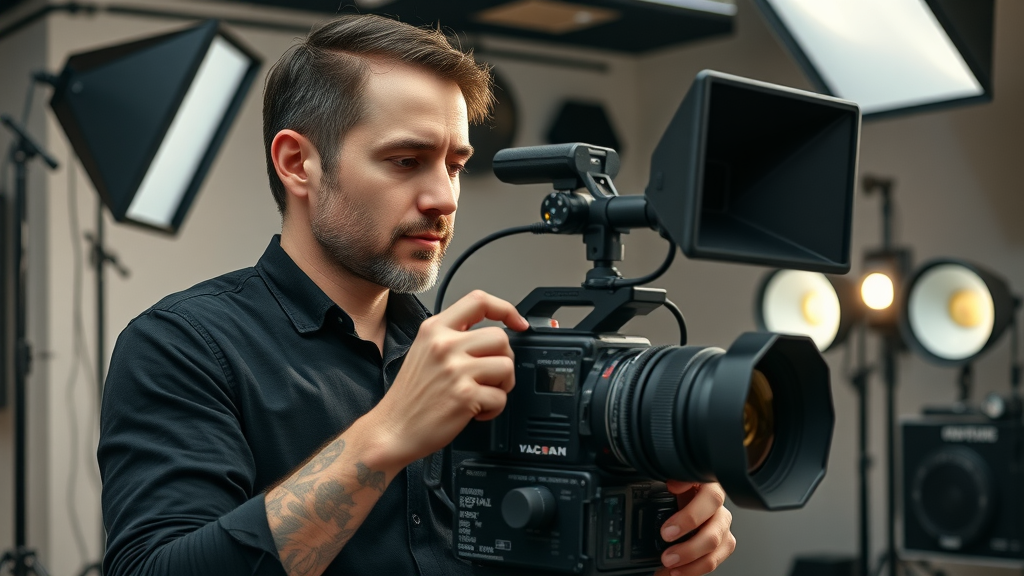- Did you know that 91% of businesses already use video as a marketing tool , with 96% considering it a crucial part of their marketing strategy? This guide delivers actionable video marketing best practices for rapid, tangible results.

Mastering Video Marketing Best Practices for Instant Impact
- Explore what video marketing best practices can do for your marketing strategy. Gain practical insights and learn through powerful real-world examples.

Video marketing best practices can transform the way your brand engages with customers and prospects. When you master these strategies, you don’t just create video content—you build moments that stick with viewers and inspire action. This is especially important as today’s audience expects authentic, concise, and relevant videos tailored to their interests. Businesses that strategically adopt video marketing see results much faster than those that stick to traditional media campaigns. For example, brands that use social media video stories or explainer videos often report a quick boost in web traffic and lead conversions within weeks of implementation.
By learning to apply effective video formatting, optimizing for each social media platform, and consistently analyzing results, marketers can achieve more with less. These quick wins aren’t just for big brands. Even small businesses using quality video can stand out amid crowded digital feeds and compete with industry giants. From eye-catching product demos to bite-sized customer testimonials, the right approach can make your video marketing shine and drive meaningful, measurable results.
What You’ll Discover in This Guide to Video Marketing Best Practices
- The critical components of impactful video marketing
- How to optimize your video marketing strategy for social media
- Tips for tailoring video content to your audience and goals
- Measurable quick wins you can achieve right away
Why Video Marketing Best Practices Matter in Every Marketing Campaign
Elevating Your Marketing Strategy with Effective Video Marketing
- Studies show that effective video increases brand recall by 85% and boosts click-through rates by up to 200%.
"Video marketing best practices transform passive viewers into active brand advocates because they speak to real needs and drive results at scale."

For any marketing campaign , following video marketing best practices means more than making videos—it’s about maximizing impact across all channels. Video content holds the power to increase brand awareness, foster engagement, and spark action, whether that’s a product purchase or a newsletter sign-up. When you craft the right type of media video for your target audience, you encourage longer video views and improved conversion rates. Even simple product demos or authentic customer testimonials can quickly boost trust and credibility when executed in line with current media platform trends.
Modern audiences crave connection and clarity. By employing effective video storytelling, brands can break through the noise of social media feeds and become memorable. Whether promoting a new product or educating users about your services, video marketing ensures your message is heard and acted upon. The right content also signals to search engines that you are relevant, helping your brand appear higher in rankings for industry keywords.
Building a Powerful Video Marketing Strategy: Foundations and Frameworks
Aligning Video Marketing Best Practices with Your Brand Goals
- Defining measurable objectives for your video marketing strategy.
- Integrating video marketing into wider marketing campaigns.

Every successful video marketing strategy begins with clear, measurable objectives. Setting goals such as increasing product awareness, driving traffic to landing pages, or boosting event attendance helps you design videos that deliver real results. Align your video marketing best practices with these targets, ensuring each video serves a distinct purpose within your broader marketing strategy.
Integration is key. Video should fit seamlessly into your marketing campaigns, complementing blog posts, email newsletters, and social media efforts. By tracking which videos generate the most engagement or sales, you can refine your campaigns for even better outcomes. Collaboration across teams—content, design, and analytics—ensures that each video campaign leverages collective knowledge and consistently represents the brand.
Identifying the Target Audience for Video Content
- Creating buyer personas
- Mapping audience journeys to select video types and platforms.
"The most successful video marketing strategies always begin with knowing exactly who you're talking to."
Defining your target audience is the foundation for making video content that resonates and converts. Start by creating detailed buyer personas based on your ideal customer's age, interests, habits, and pain points. By understanding who will watch your videos, you can create video content specifically designed for their needs, whether that's a quick product demo for busy professionals or a deep-dive explainer video for curious newcomers.
Map out your audience’s journey across platforms like Facebook, YouTube, and Instagram, as different social media video trends and formats work for different stages of the marketing funnel. For instance, Instagram reels or YouTube shorts are highly shareable, grabbing early attention, while longer form videos like webinars nurture leads further down the funnel. The right fit means more social shares, better viewer retention, and greater ROI for your marketing campaign.
Types of Video Content That Drive Engagement
Explainer Videos, Product Demos, and Beyond
- Short-form video, testimonials, social media video, live streaming
- When to use each type for different stages of the marketing funnel
| Type of Video | Best Use Case | Ideal Media Platform | Stage in Funnel |
|---|---|---|---|
| Explainer Video | Communicating complex ideas simply | Website, YouTube, LinkedIn | Awareness, Consideration |
| Product Demo | Showcasing product features and benefits | Website, YouTube, Facebook | Consideration, Conversion |
| Testimonial | Building trust through real customer experiences | Social media video, Website, Instagram | Conversion, Loyalty |
| Short-form Video | Quickly engaging audiences with bite-sized content | Instagram, TikTok, YouTube Shorts | Awareness |
| Live Stream | Real-time interaction and audience engagement | Facebook Live, LinkedIn, Instagram Live | Engagement, Loyalty |

Choosing the types of video that align with your marketing strategy is crucial for audience engagement. Explainer videos break down complicated concepts and help prospects understand your value in under two minutes. Product demos focus on showcasing real-world applications, while customer testimonials provide essential social proof. For social media video, fast-paced short-form content is most effective at grabbing attention and driving up the number of video views in crowded feeds.
Live video builds authenticity and lets viewers interact with your brand in real time, which is particularly effective for strengthening brand loyalty. Use analytics tools to monitor which media video types resonate most, and adjust your content calendar accordingly. By diversifying your video content, you can reach different audiences at various stages of their buyer journey, maximizing overall campaign performance on every video platform.
Video Production Tips: Quality Video for Every Platform
Optimizing Video Production for Social Media Platforms
- Choosing formats and lengths for Facebook, Instagram, LinkedIn, and YouTube
- Editing techniques for higher retention on each media platform
The Importance of Quality Video and Audio
- Lighting setups, camera choices, and sound best practices

When it comes to video production , quality matters—especially if you want your videos to shine across multiple media platforms . Social media users expect clear visuals and crisp audio, no matter the platform, whether that’s Facebook, Instagram, LinkedIn, or YouTube. Each network prefers different formats: for example, vertical videos are best for Instagram stories and reels, while landscape works well on YouTube. Make use of editing techniques such as fast cuts, graphics, and captions to help maintain viewer interest throughout the video view.
Lighting and sound are non-negotiable. Even with a smartphone, you can create a compelling quality video by choosing well-lit environments and minimizing background noise. For higher stakes content—like a product demo or brand explainer—invest in a shotgun microphone and a basic three-point lighting kit. Consistently deliver excellent video content, and your marketing efforts will pay off with improved watch times and better audience retention on every platform.
Crafting Compelling Video Content: Editorial and Creative Best Practices
Storytelling Secrets in Video Marketing Best Practices
- Structuring scripts for engagement
- Using emotional triggers and calls to action strategically

Great video marketing begins with an engaging story. Start every script with a hook—something that grabs attention right away, such as a startling statistic or thought-provoking question. Use a simple, clear structure: present the problem, show the solution, and end with a strong call to action. Emotional storytelling—whether humor, empathy, or excitement—helps your brand stand out and connects directly with your audience’s needs.
Every second of your video content should serve a purpose. Use music, animation, and brand elements to make your videos memorable. Calls to action (“Buy Now,” “Learn More,” “Subscribe”) should be clear and woven naturally into your story, motivating viewers to take the next step in your marketing campaign. Experiment with different approaches, track what resonates, and continuously refine your creative process.
Brand Consistency Across Social Media Video Campaigns
- Setting style guides for images, logos, colors, and messaging
"Every piece of video content should reinforce your core brand promise."
Consistency is critical across all your social media video efforts. Develop clear brand guidelines covering visual style, tone, logos, and messaging, then use these standards for every piece of video content—whether a YouTube tutorial or an Instagram story. Audiences who instantly recognize your look and feel are more likely to remember your brand and engage across multiple video platforms.
A uniform approach doesn’t sacrifice creativity; it amplifies it. Consistency builds trust, establishes authority, and reinforces the message you want to share. Leverage templates, overlays, and intros that highlight your branding, no matter the type of media video you’re producing, ensuring your marketing strategy drives long-term growth and recognition in every campaign.
Distribution: Maximizing Reach with Social Media Video Strategies
Selecting the Right Social Media Platforms for Your Video Marketing Campaign
- Choosing platforms based on target audience and media video trends

A successful video marketing campaign depends on sharing your content where your audience is most active. Research current media video trends and audience behaviors on platforms like YouTube, Facebook, Instagram, LinkedIn, or even TikTok. Consider the format each platform prefers—think vertical video for platforms like Instagram or short-form video clips for TikTok and YouTube Shorts.
Align your posting schedule with your audience’s browsing times for maximum reach. Use analytics tools to identify the media platforms delivering the most engagement, and prioritize them in your strategy. Constantly monitor platform updates and adapt your tactics to stay ahead of algorithm changes and evolving viewer preferences.
Scheduling and Promotion Best Practices
- Optimal post timing
- Paid promotions and influencer collaborations
The timing of your post can make or break social media video performance. Identify peak engagement hours by reviewing previous analytics, then schedule important video content to drop during those windows. Consider using scheduling software to plan posts in advance and maintain consistent publishing—a must for growing your video view count.
Boost reach further with paid promotions and strategic influencer collaborations. Partnering with creators or brands relevant to your marketing goal can introduce your content to new audiences. A thoughtful blend of organic and sponsored posts will help you build a loyal following and amplify every video marketing effort on each social media platform.
Analytics Tools and Metrics: Measuring Success in Video Marketing
Using Analytics Tools to Optimize Your Video Marketing Strategy
- Key metrics: views, engagement, watch time, conversion
- Popular analytics tools for video marketers
| Analytics Metric | Why It Matters | Best Analytics Tools |
|---|---|---|
| Video Views | Tracks reach and initial interest | YouTube Analytics, Facebook Insights |
| Engagement Rate | Measures likes, shares, comments, and interactions | Sprout Social, Hootsuite |
| Watch Time | Shows how long viewers stay engaged | YouTube Analytics, Vimeo Insights |
| Conversion Rate | Indicates how many viewers take the desired action | Google Analytics, Social Platforms’ Native Tools |
| Click-Through Rate | Reveals effectiveness of calls to action | Google Analytics, Platform Insights |

Measuring your results is essential to refining your video marketing strategy . Use analytics tools to dig into video views, watch time, conversion rates, and engagement metrics. Regularly check which types of video content gain traction on which platforms, and use these findings to inform future campaigns.
Whether it’s Facebook Insights, YouTube Analytics, or all-in-one dashboards like Hootsuite or Sprout Social, these tools reveal what’s working and what’s not in real time. The more you analyze and optimize, the more effective your marketing strategies become, leading to visible growth and faster achievement of marketing goals.
Adapting Video Marketing Best Practices for Different Types of Videos
Best Practices for Explainer Videos vs Promotional Videos
- Tailoring format, length, and tone for various objectives

Not all videos are created equal. An explainer video needs to be concise, straightforward, and educational, typically lasting 60-90 seconds and using animated graphics or on-screen text. Focus on clarity and keep jargon to a minimum so anyone can understand your product or service. In contrast, a promotional video is more emotive—leveraging bold visuals, music, and quick cuts to create excitement and urgency around a launch, special offer, or milestone.
Tailor every element of your video to your specific objective. From script and visual design to runtime and tone, always align your content with the action you want your viewers to take. This custom approach ensures that each type of video content supports your marketing campaign’s unique goals.
Creative Video Ideas for Every Marketing Campaign
- Case studies: Unique social media video campaigns that worked
"Innovation in video content isn't just about new technology—it's a mindset of testing and refining."
Get creative with your video marketing. Consider launching behind-the-scenes tours, day-in-the-life stories, or interactive polls to keep things fresh. A well-executed series—like daily video tips or weekly Q&A livestreams—can capture attention and build loyal followings. Look at brands that turned simple concepts (like unboxing a product or answering FAQs) into viral hits because they tested new formats and learned from direct audience feedback.
Always analyze performance data after a campaign. Try A/B testing different thumbnails, intros, or calls to action to see what drives the biggest response. With constant experimentation and a willingness to adapt, your marketing strategies will stay innovative and relevant in a competitive media landscape.
Common Pitfalls: What to Avoid in Video Marketing Best Practices
- Ignoring mobile users
- Overlooking video captions and accessibility
- Neglecting A/B testing for video content

Many marketers stumble by failing to optimize video content for mobile viewing—yet, the majority of video views come from smartphones. Use responsive video formats and double-check how your content displays on different devices to prevent loss of engagement. Another common oversight is skipping video captions, which increases accessibility for all users, including those watching with sound off or viewers with hearing impairments.
Never neglect A/B testing. Trying out different styles, thumbnails, or intro hooks can dramatically improve watch rates and conversions over time. Address these pitfalls before they impact your marketing efforts, ensuring your videos reach and resonate with your whole target audience.
People Also Ask: Essential Knowledge for Video Marketing Best Practices
What are the keys to using video marketing successfully?
- Clarity of message, understanding your audience, optimizing for social media platforms, and constant performance review.
To succeed with video marketing, focus on a clear message that speaks to your target audience . Optimize your videos for each social media platform to take advantage of unique formats and algorithms. Always review your campaign analytics tools to refine your approach and maximize results.
What are the 7 steps of content marketing?
- 1. Research audience
- 2. Define objectives
- 3. Plan content
- 4. Produce quality video
- 5. Distribute strategically
- 6. Analyze results
- 7. Refine and improve
The content marketing journey starts with understanding your audience and goals, planning content, and focusing on quality video production. Distribution and analytics tools help you measure effectiveness, while ongoing refinement ensures continued growth and results.
What is a video marketing strategy?
- A video marketing strategy is a plan that outlines how video content will help meet marketing goals, from audience targeting to platform selection and performance tracking.
A video marketing strategy guides every step in your campaign: from deciding which types of video to make, to choosing the right video platform , all the way through to tracking and optimizing outcomes. This structured approach ensures consistent, measurable progress toward key marketing goals.
What are the top 7 types of digital marketing strategies?
- 1. Video marketing
- 2. Social media marketing
- 3. Content marketing
- 4. Email marketing
- 5. Influencer marketing
- 6. SEO
- 7. Paid advertising
A successful marketing plan uses a mix of approaches. Video marketing stands out for its ability to quickly capture attention and drive engagement. Combined with social media, email, SEO, and paid campaigns, you can reach different segments for maximum brand awareness and sales.
Expert Answers to Frequently Asked Video Marketing Best Practices Questions
- How can small businesses compete in video marketing?
- What are practical examples of high-converting video content?
- How do you balance video quality and budget constraints?
- Is short-form video always better for social media?

Q1: How can small businesses compete in video marketing?
Small businesses can compete by focusing on authentic, story-driven content and leveraging cost-effective tools for video production. Use smartphone cameras, free editing software, and post consistently on the platforms where your audience spends the most time. Start small, monitor analytics, and scale what works.
Q2: What are practical examples of high-converting video content?
Demos of your product or service, unboxing videos, how-to tutorials, and customer testimonials are all high-converting video types. These videos build trust, clarify value, and drive viewers to take the next step, whether it’s signing up for a free trial or contacting your sales team.
Q3: How do you balance video quality and budget constraints?
Prioritize strong lighting, clear audio, and concise storytelling over fancy effects. Rent equipment if needed or use your phone creatively. Focus your resources on making a few high-impact videos rather than many low-quality ones, and always plan for edits in advance to reduce production costs.
Q4: Is short-form video always better for social media?
Short-form video often performs well by grabbing attention quickly—especially on platforms like TikTok, Instagram Reels, and YouTube Shorts. However, for educational content or product demos, longer videos might be more effective. Match your video length to the platform and your marketing goal for best results.
Checklists and Takeaways: Implementing Video Marketing Best Practices
- Audit your current marketing strategy for video integration
- Define clear campaign objectives
- Customize video content by platform
- Invest in quality production tools
- Monitor performance with analytics tools
- Iterate based on feedback and data

Ready to Transform Your Business with Video Marketing Best Practices?
- Stop guessing. Start growing. Call now for real marketing strategies that get results. 772-349-1529
Take immediate action on these video marketing best practices to boost brand awareness and conversions—your business’s next big win starts today.
 Add Row
Add Row  Add
Add 




Write A Comment